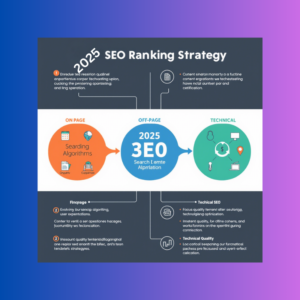SEO Behind the Scenes in 2025
Published: 02 Feb 2025
Ranking Strategies and Methods
SEO Behind the Scenes in 2025 has evolved rapidly, and 2025 is no different. The competition is fierce, search engines are smarter, and ranking high requires more than keywords. So, what happens behind the scenes of SEO in 2025? Explore the latest strategies and methods to improve rankings and dominate search results.
1. Understanding Google’s AI-Powered Search Algorithms
Google‘s AI algorithms like RankBrain, BERT, and MUM have redefined how content is ranked. In 2025, these algorithms prioritize:
- User Intent Matching: Content must align with what users want to seek.
- E-E-A-T (Experience, Expertise, Authoritativeness, and Trustworthiness): Quality content from credible sources ranks higher.
- Semantic Search & NLP: Google understands content context, not just keywords.
How to Optimize for AI-Powered Algorithms?
- Write natural, engaging, and well-researched content not to write long and complex content.
- Use easy and structured data (Schema Markup) to help search engines understand your content.
- Optimize for People Also Ask (PAA) and featured snippets.
- Ensure your site has a strong backlink profile from authoritative sources.
2. Technical SEO: The Hidden Power of Optimization
Technical SEO is optimizing a website’s infrastructure to ensure search engines can efficiently crawl, index, and rank its content. By addressing key technical elements such as site speed, mobile-friendliness, structured data, XML sitemaps, and URL structure, Technical SEO helps improve your website’s overall visibility and performance in search engine results pages (SERPs). Proper implementation ensures that search engine bots can easily access and interpret your site’s content, leading to better indexing and higher rankings, ultimately driving more organic traffic to your
Key Technical SEO Factors in 2025:
Core Web Vitals & Page Experience
- Why it matters: Google continues to prioritize user experience, and Core Web Vitals (CWV) remain a significant ranking factor.
- Key Metrics :
- Largest Contentful Paint (LCP): Measures loading performance. Aim for under 2.5 seconds.
- First Input Delay (FID): Measures interactivity. Ensure FID is below 100ms.
- Cumulative Layout Shift (CLS): Tracks visual stability. Aim for a CLS score of less than 0.1.
- Action Steps :
- Optimize images and leverage lazy loading.
- Minimize JavaScript execution time.
- Avoid intrusive ads or elements that cause layout shifts.
. Mobile-First Indexing
- Why it matters: Google predominantly uses the mobile version of content for indexing and ranking. A poor mobile experience can severely impact rankings.
- Key Considerations :
- Ensure your site is fully responsive and mobile-friendly.
- Match content between desktop and mobile versions (no missing content on mobile).
- Use structured data consistently across both versions.
- Action Steps :
- Test your site using Google’s Mobile-Friendly Test.
- Optimize touch elements and ensure fast load times on mobile devices.
. Site Speed & Performance Optimization
- Why it matters: Faster websites provide better user experiences and are favored by search engines.
- Key Areas to Focus On :
- Server response times TTFB (Time to First Byte).
- Do image optimization (use modern formats like WebP).
- Minification of CSS, JavaScript, and HTML.
- Action Steps :
- Use Content Delivery Networks (CDNs) to reduce latency.
- Implement browser caching and compression techniques (e.g., Gzip or Brotli).
- Regularly audit site speed using tools like Google PageSpeed Insights or GTmetrix.
. Structured Data & Schema Markup
- Why it matters: Structured data helps search engines understand your content better, enabling rich snippets and enhanced SERP features.
- Key Types of Schema :
- Article, FAQ, How-To, Product, Review, and Event Schemas.
- Local Business schema for location-based searches.
- Action Steps :
- Use Google’s Structured Data Markup Helper to implement schema.
- Validate your structured data using the Rich Results Test tool.
- Keep schema up-to-date with any changes in content or business offerings.
. Secure Websites (HTTPS)
- Why it matters: Security is a top priority for users and search engines. HTTPS ensures data encryption and builds trust.
- Key Considerations :
- Ensure all pages are served over HTTPS.
- Redirect HTTP to HTTPS to avoid duplicate content issues.
- Action Steps :
- Install an SSL certificate and regularly renew it.
- Monitor for mixed content issues (HTTP resources on HTTPS pages).
. Crawlability & Indexability
- Why it matters: If search engines can’t crawl or index your site, your content won’t appear in search results.
- Key Elements :
- Robots.txt: Ensure important pages aren’t blocked from crawling.
- XML Sitemap: Submit an updated sitemap to search engines.
- Canonical Tags: Prevent duplicate content issues by specifying preferred URLs.
- Action Steps :
- Use Google Search Console to monitor crawl errors and fix them promptly.
- Check for orphaned pages (pages not linked internally).
- Regularly update your XML sitemap and submit it via Google Search Console.
. Internal Linking Structure
- Why it matters: A well-structured internal linking strategy helps distribute page authority and improves user navigation.
- Key Considerations :
- Use descriptive anchor text for internal links.
- Ensure a logical hierarchy (e.g., silo structure).
- Action Steps :
- Audit your internal links to remove broken or irrelevant ones.
- Add contextual links to related content to improve engagement and dwell time.
. Duplicate Content & Canonicalization
- Why it matters: Duplicate content can confuse search engines and dilute your ranking potential.
- Key Solutions :
- Use canonical tags to indicate the preferred version of a page.
- Avoid publishing identical content across multiple URLs.
- Action Steps :
- Use tools like Siteliner to identify duplicate content.
- Implement 301 redirects for outdated or duplicate pages.
. Voice Search Optimization
- Why it matters: With the rise of smart speakers and voice assistants, optimizing for voice search is becoming increasingly important.
- Key Strategies :
- Focus on conversational, long-tail keywords.
- Provide clear, concise answers to common questions.
- Action Steps :
- Optimize FAQ sections for voice search queries.
- Ensure your site is fast and mobile-friendly, as voice searches often occur on mobile devices.
. AI & Machine Learning Integration
- Why it matters: Search engines like Google are increasingly relying on AI (e.g., RankBrain) to understand user intent and deliver relevant results.
- Key Considerations :
- Focus on creating high-quality, relevant content that satisfies user intent.
- Use natural language processing (NLP) techniques to optimize for semantic search.
- Action Steps :
- Leverage AI tools to analyze content gaps and improve readability.
- Monitor how AI-driven algorithms may affect your rankings and adjust strategies accordingly.
. International & Multilingual SEO
- Why it matters: If you target global audiences, ensuring proper localization and hreflang tags is essential.
- Key Elements :
- Use hreflang tags to indicate language and regional targeting.
- Create localized content for different regions.
- Action Steps :
- Use hreflang tags correctly to avoid duplicate content issues.
- Use country-specific domains or subdirectories for international targeting.
. Zero-Click Searches & Featured Snippets
- Why it matters: More searches are being answered directly in SERPs through featured snippets, knowledge panels, and other zero-click results.
- Key Strategies :
- Optimize for featured snippets by providing concise, well-structured answers.
- Target question-based queries and use bullet points or numbered lists.
- Action Steps :
- Analyze competitors’ featured snippets and aim to outrank them.
- Use tools like SEMrush or Ahrefs to identify opportunities for snippet optimization.
3. Content SEO: The Core of Ranking Success
Google now prioritizes quality, user-focused content that keeps visitors engaged. Content SEO Behind the Scenes in 2025 refers to the practice of creating and optimizing high-quality, relevant, and valuable content to rank higher in search engine results and attract organic traffic. It focuses on aligning content with user intent, targeting the right keywords, and providing answers to users’ queries effectively.
Content Strategies for 2025:
- Keyword Research: Identifying relevant search terms your audience uses.
- High-Quality Content: Crafting engaging, informative, and original content that satisfies user needs.
- On-Page Optimization: Proper use of headings, meta tags, internal linking, and keyword placement.
- User Intent: Matching content to what users are searching for (informational, navigational, transactional).
- Content Updates: Regularly refreshing and improving existing content to stay relevant.
4. AI and Automation in SEO
Automation tools powered by AI are shaping the future of SEO. WITH AI and Automation in SEO involve leveraging artificial intelligence and automated tools to streamline and enhance search engine optimization efforts. These technologies help analyze data, predict trends, and optimize strategies more efficiently than manual processes.
AI SEO Tools & Methods:
- AI-Generated Content: Using tools like ChatGPT and Jasper to create optimized content.
- Keyword Research & Content Optimization: AI tools identify high-potential keywords and suggest content improvements for better rankings.
- User Intent Analysis: Machine learning algorithms understand search intent and recommend content that aligns with user needs.
- Predictive SEO: AI analyzes trends and suggests future ranking opportunities.
- Automated Internal Linking – AI-driven link building enhances site structure.
- AI-Based Chatbots & Assistants – Improve user engagement and dwell time.
5. Link-Building in 2025: Smarter and Safer
Link-Building in 2025: Smarter and Safer emphasizes the evolution of backlink strategies to align with advanced search engine algorithms, user-centric approaches, and ethical practices. As search engines like Google become more sophisticated, link-building will focus on quality, relevance, and authenticity over sheer quantity.
Effective Link-Building Strategies:
- Brand Mentions & Digital PR: Get featured in reputable publications.Quality Over Quantity
- Focus on earning high-authority, relevant backlinks from trusted websites rather than acquiring many low-quality links.
- Prioritize links from niche-specific domains that align with your industry or audience.
- Contextual & Niche-Specific Links: Build links from authoritative sites in your niche.Ethical and White-Hat Practices
- Avoid risky tactics like buying links, PBNs (Private Blog Networks), or excessive link exchanges, which can lead to penalties.
- Focus on natural link growth through organic promotion and valuable contributions to your niche.
- HARO (Help A Reporter Out): Gain backlinks by answering journalist queries.Localized and Niche-Specific Links
- For local SEO, prioritize links from local directories, news outlets, and community websites to boost visibility in specific geographic areas.
- Target niche-specific platforms and forums where your audience actively engages.
- AI-Powered Outreach: Automate and personalize link outreach efforts.Relationship-Based Outreach
- Build genuine relationships with influencers, bloggers, and industry leaders through personalized, value-driven outreach.
- Collaborate on guest posts, expert roundups, or co-created content to earn authoritative links.
6. Local SEO & Hyperlocal Strategies
Local SEO is crucial for businesses targeting regional audiences. Local SEO & Hyperlocal Strategies focus on optimizing a business’s online presence to attract customers from specific geographic areas, especially for location-based searches. It’s crucial for brick-and-mortar stores, service-area companies, and local service providers.
Optimizing for Local SEO:
- Google Business Profile Optimization:- Optimize your profile with accurate business information, photos, reviews, and posts to improve visibility in local search results and Google Maps.
- Local Citations & Reviews:– Target location-specific keywords (e.g., “best pizza in Pakistan”) to align with user intent. Build listings on reputable local directories (e.g., Yelp, Yellow Pages) to enhance authority. Encourage positive customer reviews to boost work and rankings.
- Voice Search for Local Queries:– Optimize for “near me” searches.
- AI-Based Local Search Tracking:– Use AI tools to monitor local rankings.
7. User Experience (UX) and SEO
User Experience (UX) and SEO go hand in hand because search engines like Google prioritize websites that provide a great experience for users. But, if your site is easy to use, fast, and enjoyable, both users and search engines will love it.
UX SEO Best Practices:
- Improve site speed and minimize layout shifts.
- Use clear navigation and engaging design.
- Reduce bounce rate by enhancing content readability.
- Optimize for mobile users with a responsive design.
8. Social Media & SEO: The Connection
The Connection is all about how social media indirectly boosts your search engine rankings by driving traffic, building brand awareness, and increasing content visibility. While social signals (likes, shares, etc.) aren’t direct ranking factors, they help your content reach more people, which can lead to more backlinks and engagement.
Social Media Strategies for SEO:
- Share SEO-optimized content across platforms.
- Leverage user-generated content for trust-building.
- Use AI-powered social listening tools to track trends.
- Focus on video content to boost engagement and traffic.
9. Ranking Strategy for 2025
A solid SEO strategy requires a mix of on-page, off-page, and technical SEO. The Ranking Strategy for 2025 revolves around adapting to evolving search engine algorithms, user expectations, and technological advancements. To succeed, focus on a holistic approach that combines content quality, technical optimization, and user-centric strategies.
Step-by-Step Ranking Strategy:
- Keyword Research with AI – Find trending and long-tail keywords.
- Content Optimization – Write in-depth, structured, and engaging content.
- Technical SEO Fixes – Ensure fast, mobile-friendly, and secure sites.
- Link-Building & Digital PR – Earn high-quality, relevant backlinks.
- AI-Driven SEO Audits – Use tools like Rank Math and Surfer SEO.
- Monitor & Adapt – Track rankings and update content regularly.
Frequently Asked Questions (FAQs)
1. What is the most important SEO factor in 2025?
The most important factor is a combination of E-E-A-T, AI-driven search algorithms, and user experience (UX). Google prioritizes sites that provide value, authority, and a seamless user experience.
2. How do I optimize my content for AI-driven search engines?
Focus on semantic search, natural language processing (NLP), and structured data. Ensure content is clear, authoritative, and aligned with user intent.
3. Are backlinks still important for SEO in 2025?
Yes, but quality matters more than quantity. Get backlinks from reputable, niche-relevant sources and focus on digital PR strategies.
4. What role does AI play in SEO?
AI helps with content generation, keyword research, site audits, and predictive SEO. It automates and improves various aspects of SEO strategy.
5. How can I improve my website’s technical SEO?
Ensure fast loading times, mobile-first design, HTTPS security, structured data implementation, and proper indexing. Use AI tools for technical audits and improvements.
Conclusion
SEO in 2025 is smarter and more competitive than ever. By focusing on AI-driven strategies, high-quality content, and strong technical SEO, you can stay ahead of the competition. Keep optimizing, adapting, and leveraging the latest tools to rank higher in search results.
Are you ready to master SEO in 2025? Start implementing these strategies today!





